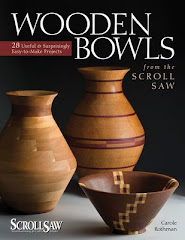I've been trying out some different designs lately, which require more precise cutting than I generally have to do. This has forced me to be aware of things that I had not considered seriously, such as where on the line you cut. The answer would seem to be simple--just cut on the line. However, unless you're using a pattern with very thin lines, most lines have two edges and a center, and where you cut does make a difference.
For example, if I'm cutting a piece that will be glued on its cut edge to another piece, I'll probably need to sand or joint the edge. In this case, I'll cut to the outside of the line, which lets me straighten out the edge and keep the required size. If, however, this is not the case and I'll probably be OK with the cut edge and no sanding, I cut carefully right down the middle of the line.
Or, if I'm cutting several pieces that need to fit together, I have to account for the wood lost to the kerf. Sometimes it doesn't matter, and the pieces will line up tightly without adjustment, but if there are center pieces, those may need to be cut on the outside of the line to prevent gaps. On the project pictured, the double ring box from the new box book, I used a very thin blade to keep the kerf small and I stack cut the pieces to create the bloodwood insert. Since the pieces were glued to a backing, any tiny spaces would not matter. The alternative would have been to inlay the bloodwood, but I wanted to keep this simple.
Wednesday, February 15, 2012
Subscribe to:
Post Comments (Atom)






Hi Carole just found your blog today, I will be ordering a Hegner 22" scrollsaw tomorow from advanced machinery. I have never done any scrolling before but I can't wait to get it and give it a go. My initial interest will be intarsia.
ReplyDeleteHi Steve. Glad you found the blog. If you use the search box, that will make it easier to access the older posts and videos.
ReplyDeleteCongratulations on your purchase of a really super scroll saw. Hanns Derke, of Advanced Machinery, is very helpful, and I've never regretted getting mine.
The skills you'll develop with intarsia will serve you well for other types of scrolling. I use elements of intarsia in the new box book, and with some other projects I'm working on. And if you ever get into making bowls, your shaping skills will certainly come in handy.
Good luck, and have lots of fun!
Carole went out this morning and was quite happy to find one of your books at a local store. I purchased wooden bowls and ordered wooden boxes, you have a real talent. And your videos on this Blog are really interesting to me, keep up the good work.
DeleteThanks, Steve, for the kind words. I hope you enjoy the projects, and if you have any questions or would like to show me pictures of your work, just use the email at the top of the column on the right.
ReplyDeleteI have been using a technique that I think would help in these situations. If you tilt your table 4 to 6 degrees, depending on the thickness of the wood, you can tape the show piece and the "through inlay" piece together and cut them simultaneously. If you keep the blade on the correct side of the piece the result will be two pieces that are beveled inward from the bottom to top. Because of the angle of the blade the bottom piece will be slightly bigger than the top accounting for the kerf of the blade. The bottom piece fits perfectly into the void left in the top. The trick is how to start the cut. Simply drill a hole right on the pattern line through both pieces at the same angle as scroll saw table. Thread your blade into the hole and cut the pattern line. I hope this makes sense. This technique eliminates any need to spend time fitting your piece into your hole.
ReplyDelete